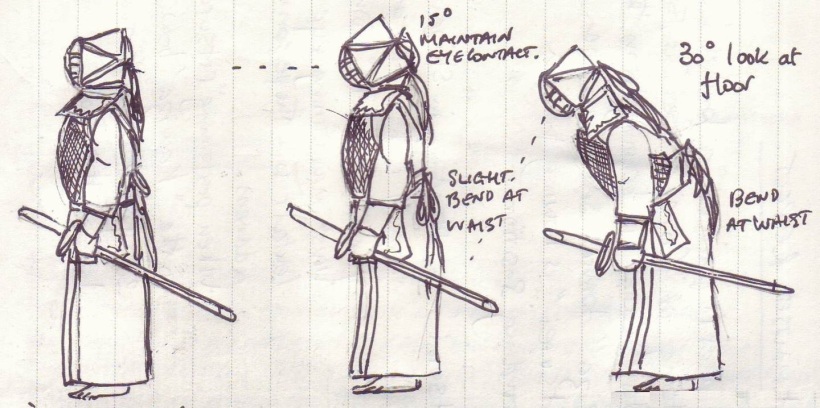All simple commands in the training session will be given in Japanese. Beginners won’t be expected to know them all, but you’ll become more familiar with the terms as time goes on.
The etiquette expected of you from the moment you enter the dojo to when you exit is fully explained on the Hizen Kendo Club website (www.hizen.info/dojo/). An abridged list of the terms is provided below.
Starting and ending the session
seiretsu – 整列 – line up in approximate grade order, with the most senior students furthest away from the dojo exit
chakuza – this is a command to sit down although some dojo will call “seiza” instead
seiza – 正坐 – sit/kneel down (always lowering the left leg first) with knees shoulder-width apart, toes together and palms neatly on your lap with your thumbs tucked in
kiza – this is an alternative sitting position identical to seiza except that the toes are tucked in underneath you when you sit. We do not use this position in Kendo.
kiritsu – 起立 – stand up (always raising the right leg first)
Either one of the following is said before mokuso:
– ki wo tsukete – 気を付けて – pay attention
– shisei wo tadashite – 姿勢を正して – correct/straighten your posture
mokuso – 黙想 – (start) meditation: rest your left hand over your right hand in the middle of you lap with the thumbs almost touching, lower your sight to look no further than halfway across the dojo and control your breathing
mokuso yame – 黙想止め – stop meditation and revert back to normal seiza posture
shomen ni rei – 正面に礼 – bow (rei) to the front of the dojo
joseki ni rei – an alternative to shomen ni rei
kamiza ni rei – another alternative to shomen ni rei
shinzen ni rei – if the dojo has a shrine you may here this command instead shomen ni rei
sensei ni rei – 先生に礼 – bow to your sensei (teacher), saying:
– onegaishimasu – お願いします – please, at the start; and
– arigato gozaimasu – ありがとうございます – thank you very much, at the end
otagai ni rei – お互いに礼 – bow to each other (both teachers and students)
During the session
men (wo) tsuke – 面(を)付け – put on your armour
men (wo) tore – 面を取れ – remove your armour
sonkyo – 蹲踞 – draw your sword into the chudan position and squat down
hajime – 始め – start
yame – 止め – stop (also signified by the sensei banging of the handle of their shinai against the floor when the dojo is noisy)
osame to – 納刀 – return your sword to the sheathed position by your left hip
yasume – a relaxed position with the feet together or shoulder width apart and the sword held in both hands pointing down and to the right

